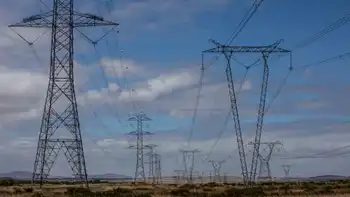Solar power expected to shine
TORONTO, ONTARIO - The Ontario Power Authority says there's great potential for solar power in the province, but sometimes you have to wonder whether it truly believes what it says.
One of the authority's more recent discussion papers assumes that solar, for planning purposes, "has a near-term potential of 50 MW rising to 100 MW towards the end of the planning period."
A potential of 50 megawatts within the next few years and 100 megawatts by 2025 may seem like a lot, considering the poor track record of solar in Canada. But such a forecast appears out of sync with global trends and the latest local developments.
The fact is solar isn't just about putting a few panels on the rooftops of homes anymore. Increasingly, investors and utilities are looking at large-scale solar power plants that over time — some say within the next 10 to 15 years — are expected to be cost-competitive with conventional fossil-fuel systems during expensive peak hours.
Take the announcement from Baltimore-based SunEdison LLC and SkyPower Corp. of Toronto. The companies have created a joint venture that plans over the next few years to "develop, build, own and operate up to 50 MW of solar photovoltaic farms across Ontario."
In other words, the power authority's near-term potential target has been achieved with just a single announcement. And industry experts say this is just the first of many announcements to come.
Kerry Adler, chief executive and president of SkyPower, says the decision to build solar farms in Ontario was a direct response to the province's new standard offer program, which goes into effect next week and offers to pay 42 cents for every kilowatt-hour of electricity that's generated from small solar projects — that is, any project under 10 megawatts.
The 42 cents is not a "knock your socks off" price, says Adler, but it's enough so far to attract the attention of investors. SunEdison and SkyPower are planning three to five projects over the next three years, each just under the 10-megawatt cap.
If they hit the 50-megawatt target, that would represent an investment of about $450 million in the province, creating hundreds of Ontario jobs and huge momentum for Canada's burgeoning solar industry.
It can't be emphasized enough: This is a huge deal.
The joint venture's first project, which will be announced within the next few weeks, will involve the installation of 50,000 solar PV panels over several hundred acres of farm land that's no longer economically viable. The studies have been done, approvals have been granted, and the mayor of the host community is apparently hyped.
"Nobody ever undertook a facility of this magnitude on the continent," says Adler, adding that future projects could be located on reclaimed industrial "brownfield" land.
"What we're trying to do is set an example that I hope others will follow."
Again, for some perspective, the largest solar PV system in Canada today is a 100-kilowatt system atop the Horse Palace at Exhibition Place. The first project Adler is talking about would be 100 times larger, and would nearly equal all of the solar capacity that has been installed in Canada over the last 20 years.
Other large solar farms exist or are being planned around the planet.
Two weeks ago an Australian-based company called Solar Systems said it had received $110 million in government funding to build a massive 154-megawatt solar power station in northwest Victoria. Australia's prime minister, John Howard, has been talking up the project to deflect criticism that he's not doing enough about climate change.
There's even been talk — tough to say how serious — of a 300-megawatt facility in New Mexico that would be laid across 1,300 hectares of land. It would produce about as much power as an average-sized natural gas plant.
But the real action is happening in Europe. A 20-megawatt project is already underway in Spain and an 11-megawatt farm is being deployed in Portugal.
Germany, meanwhile, is years ahead of the game with the biggest solar farms already in operation. The Solar Park Gut Erlsasee near Arnstein is the largest in the world at 12 megawatts. The system is designed so that each panel tracks the movement of the sun, maximizing electricity production. SkyPower and SunEdison plan a similar approach in Ontario.
Germany's Bavaria SolarPark is rated at 10 megawatts, but it's actually composed of three separate farms. Several other multi-megawatt facilities are scattered across the country.
"If you look at Canada as a country, it has more solar radiation on average than Germany does, particularly where people live. So you can see the potential there," says Jigar Shah, founder and CEO of SunEdison.
"If Germany, with its population and land mass, can achieve 700 to 800 megawatts a year worth of solar, Canada can easily achieve the same."
Shah says the solar market in North America should be able to achieve growth rates of 50 per cent a year, thanks to progressive legislation in California and Ontario's standard-offer program, which are both prompting other jurisdictions to follow.
And he says the opportunities are just beginning. "I think the decade of 2010 to 2020 will be the decade of solar power."
Rob McMonagle, executive director of the Canadian Solar Industries Association, says the buzz around solar is getting louder in Canada and political support is growing. More than 270 people attended the industry's annual conference in Ottawa, double the attendance from a year ago.
Gary Lunn, minister of Natural Resources Canada, gave a keynote presentation, making him the first federal minister to speak at the event in two decades. An industry that two years ago was struggling to get attention is now at the centre of it.
"My message is, we are the next Germany of solar, and that's simply because we've got so much catching up to do," says McMonagle.
And the SunEdison and SkyPower announcement may be just the tip of the iceberg. "I know there are other announcements coming up in the next couple of weeks," he adds. "We're getting some big interest from American companies that say we can do this."
That could be both a curse and a blessing. McMonagle wants to see these big projects emerge, but blowing past the power authority's low forecast at such an early stage could ultimately undermine the program.
"It's a little bit of a concern," he says. "With their low target (being exceeded), there's a justification for cutting back the incentive."
Or killing it entirely.
Such a knee-jerk reaction would be a grave mistake, particularly if Ontario is serious about building a solar industry that creates jobs and can contribute hundreds of megawatts of emission-free electricity to a province trying to clean up its image.
The time will come to claw back the premium on solar. But we've got a few years yet to go.
Related News

Cape Town to Build Own Power Plants, Buy Additional Electricity
CAPE TOWN - Cape Town is seeking to secure more than 450 megawatts of power from renewable sources to cut reliance on state power utility Eskom Holdings SOC Ltd. and reduce greenhouse gas emissions.
South Africa’s second-biggest city is looking at a range of options and expects the bulk of the electricity to be generated from solar plants, Kadri Nassiep, the city’s executive director of energy and climate change, said in an interview.
On July 14 the city of 4.6 million people released a request for information to seek funding to build its own plants. This month or next it will seek…




